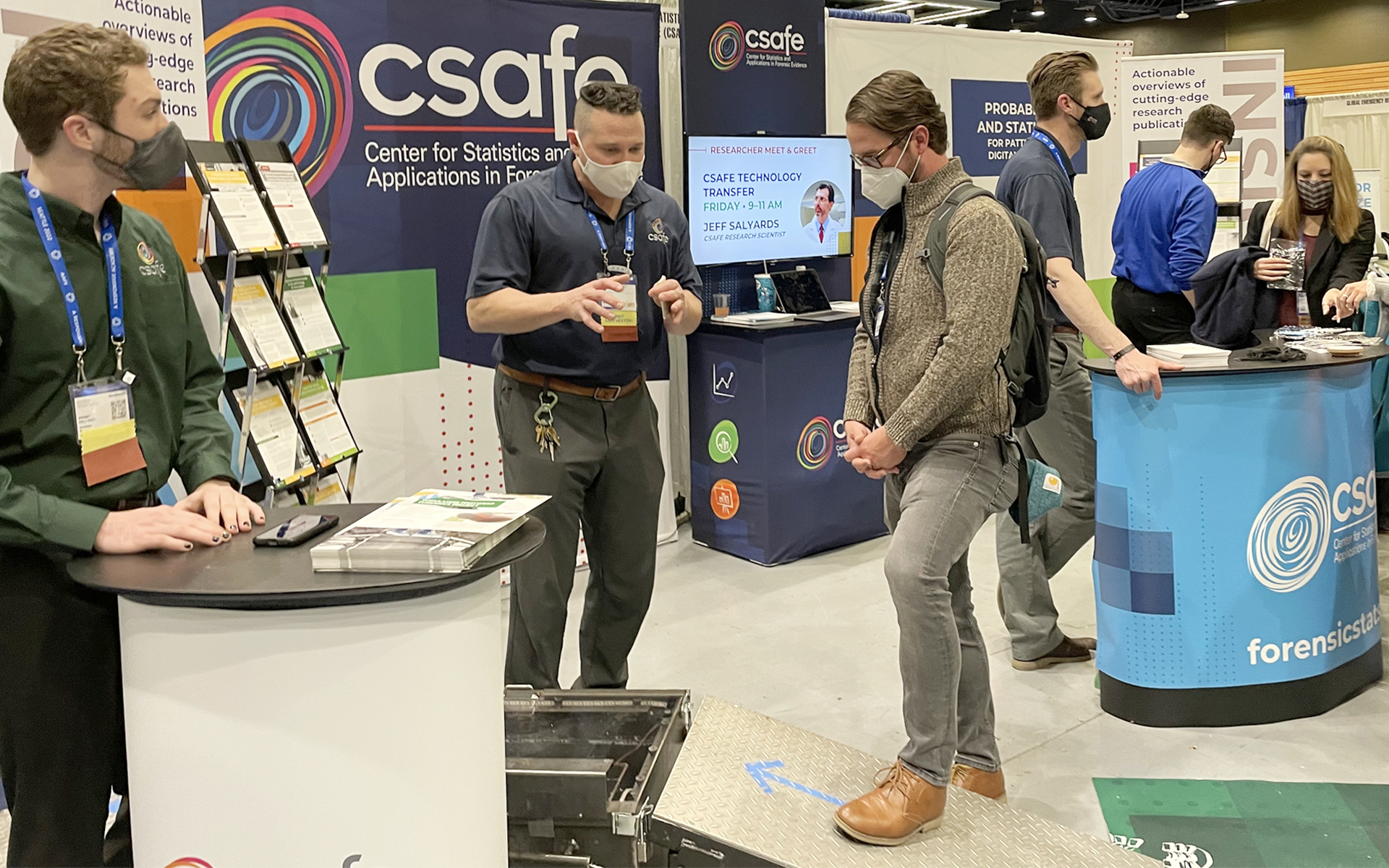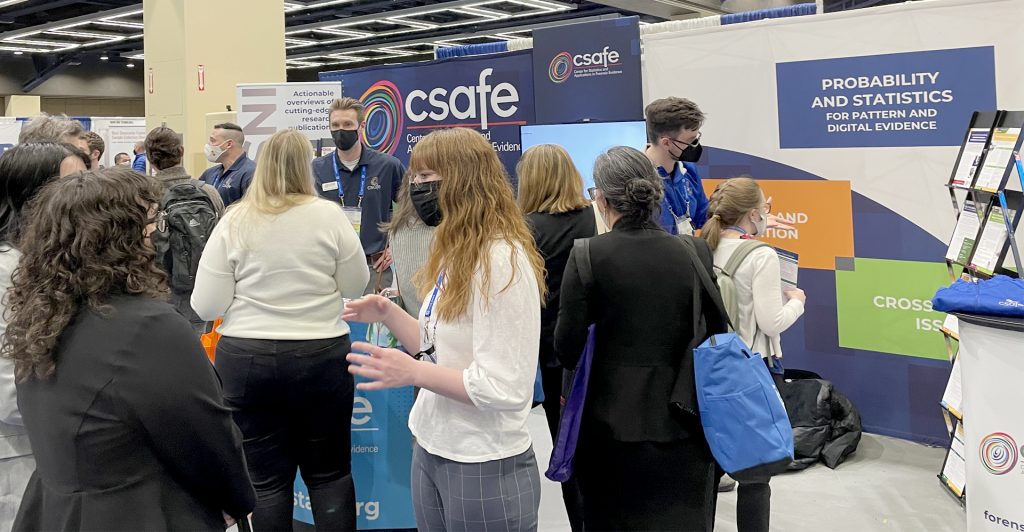The Center for Statistics and Applications in Forensic Evidence (CSAFE) faculty, students and staff attended the American Academy of Forensic Sciences (AAFS) annual scientific conference. The conference was held Feb. 21–25 in Seattle, Washington.

CSAFE was a conference sponsor and had a booth in the exhibit hall. More than 500 attendees visited the booth to learn more about CSAFE research and learning opportunities.
“AAFS was a fantastic opportunity to reach people unfamiliar with the mission and offerings of CSAFE, as well as to reconnect with so many who have already found our work to be beneficial,” said Anthony Greiter, the learning and development specialist at CSAFE. “I expected to interact with the practitioner and faculty communities but was overjoyed to speak with so many undergraduate and graduate students who are excited to be the next generation of forensic science practitioners and researchers.”
Conference attendees interacted with new CSAFE technologies, including the footwear data collection system and a handwriting analysis software app. Richard Stone, associate professor of industrial and manufacturing systems engineering at Iowa State University; Braden Westby, a senior in mechanical engineering at Iowa State; and Jayden Stack, a graduate student in statistics at University of Nebraska-Lincoln, were on hand to explain how the footwear scanner takes real-time video of a gait as a shoe comes in contact with the device.
Attendees also watched demonstrations of CSAFE’s handwriter software tool. Stephanie Reinders, CSAFE research scientist, and Felix Baez-Santiago, a senior in data science at Iowa State, showed attendees a variety of functions in handwriter that can identify letters and features from handwritten documents.
There were also scheduled meet-and-greets with CSAFE researchers at the booth. Alicia Carriquiry, CSAFE director, talked with attendees about current and future research at the Center. Jeff Salyards, CSAFE research scientist, shared CSAFE’s plans for implementing a variety of current research. Melissa Nally, senior firearms examiner at the Houston Forensic Science Center and CSAFE research collaborator, discussed her recent black box study of bullets fired from consecutively rifled barrels.
In addition, several CSAFE researchers presented their research projects during a seminar, scientific sessions and poster sessions. Below is a list of the presentations.

CSAFE Presentations
An asterisk (*) denotes a CSAFE researcher or collaborator.
SEMINAR
Autopsy of a Crime Lab: The Evolving Approaches Toward Forensic Evidence in Court
Brandon Garrett*SCIENTIFIC SESSIONS
Score-Based Likelihood Ratios for Camera Device Identification Using Cameras of the Same Brand for the Alternative Device Population
Stephanie Reinders*, Danica Ommen* and Alicia Carriquiry*Algorithmic Fairness: Sampling and Algorithmic Bias Correction in Machine Learning with Applications to Forensic Evidence
Ganesh Krishnan* and Heike Hofmann*How Do Latent Print Examiners Perceive Blind Proficiency Testing? A Survey of Practicing Examiners
Brett Gardner*, Sharon Kelley* and Maddisen Neuman*What Types of Information Can and Do Latent Print Examiners Review? A Survey of Practicing Examiners
Brett Gardner*, Sharon Kelley* and Maddisen Neuman*Does Image Editing Improve the Quality of Latent Prints? An Analysis of Image-Enhancement Techniques in One Crime Laboratory
Brett Gardner*, Sharon Kelley* and Maddisen Neuman*Automatic Class Characteristic Recognition in Shoe Tread Images
Jayden Stack* and Susan Vanderplas*An Open-Source Implementation of the Congruent Matching Profile Segments (CMPS) Algorithm for Assessing the Similarity of Bullets
Wangqian Ju* and Heike Hofmann*An Accessible Open-Source Implementation of the Congruent Matching Cells Algorithms for Cartridge Case Analysis
Joseph Zemmels*, Susan VanderPlas* and Heike Hofmann*Investigative Leads in Latent Prints: A Comparison of Laboratory Procedures
Amanda Wilson, Sharon Kelley*, Jennifer Molina, Brett Gardner* and Maddisen Neuman*Forensic Analysis on Cryptocurrency Wallet Apps
Chen Shi* and Yong Guan*Measuring Proficiency Among Latent Print Examiners: A Statistical Approach from Standardized Testing
Amanda Luby*Toward the Quantitative Evaluation of Pattern Evidence
Alicia Carriquiry*SCIENTIFIC POSTER SESSIONS
Assessing the Dependency Structure Between Shape Codes for Forensic Handwriting Data
Cami Fuglsby, Kayla M. Moquin, Christopher P. Saunders, Danica Ommen*, Michael Caliguiri and JoAnn BuscagliaLikelihood Ratios for Categorical Evidence with Applications in Digital Evidence
Rachel Longjohn*, Padhraic Smyth* and Hal Stern*YOUNG FORENSIC SCIENTIST FORUM (YFSF) POSTER SESSION
A New Algorithm for Source Identification of Look-Alike Footwear Impressions Based on Automatic Alignment
Hana Lee* and Alicia Carriquiry*Ensemble of SLR Systems for Forensic Evidence
Federico Veneri* and Danica Ommen*Towards a Score-Based Likelihood Ratio for Footwear Analysis
Valerie Han* and Alicia Carriquiry*




